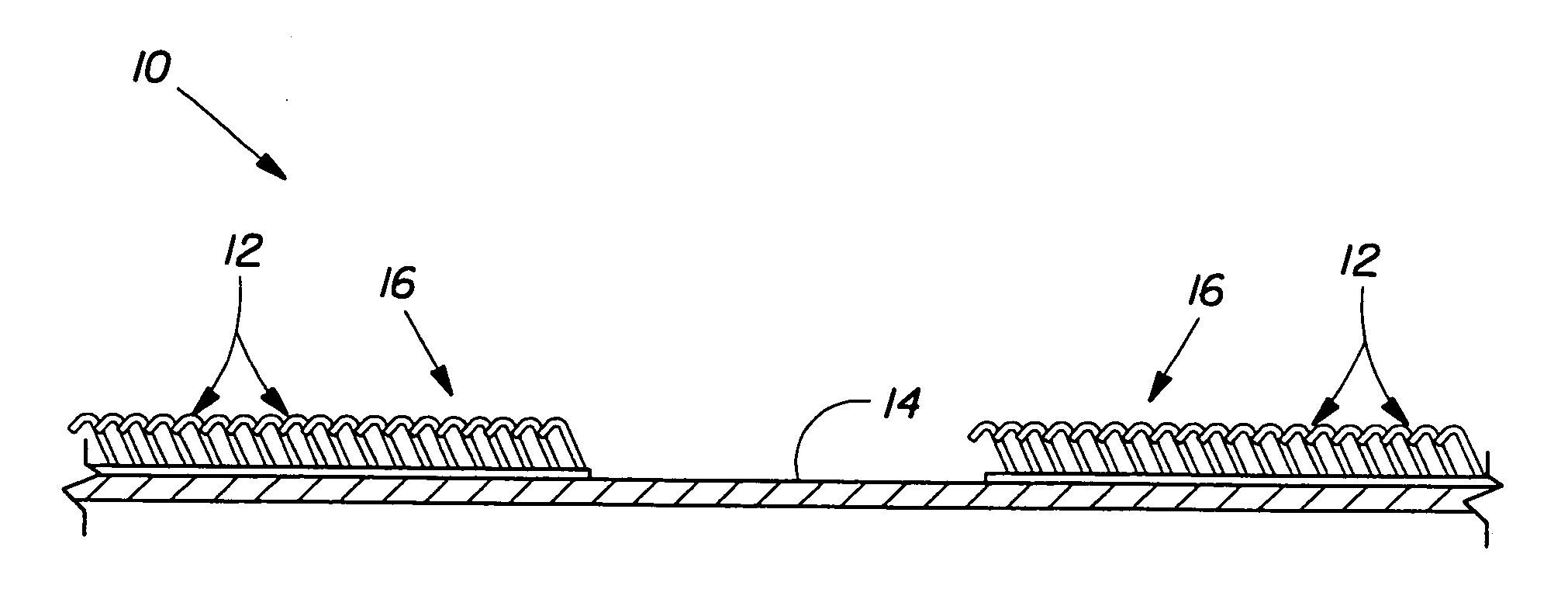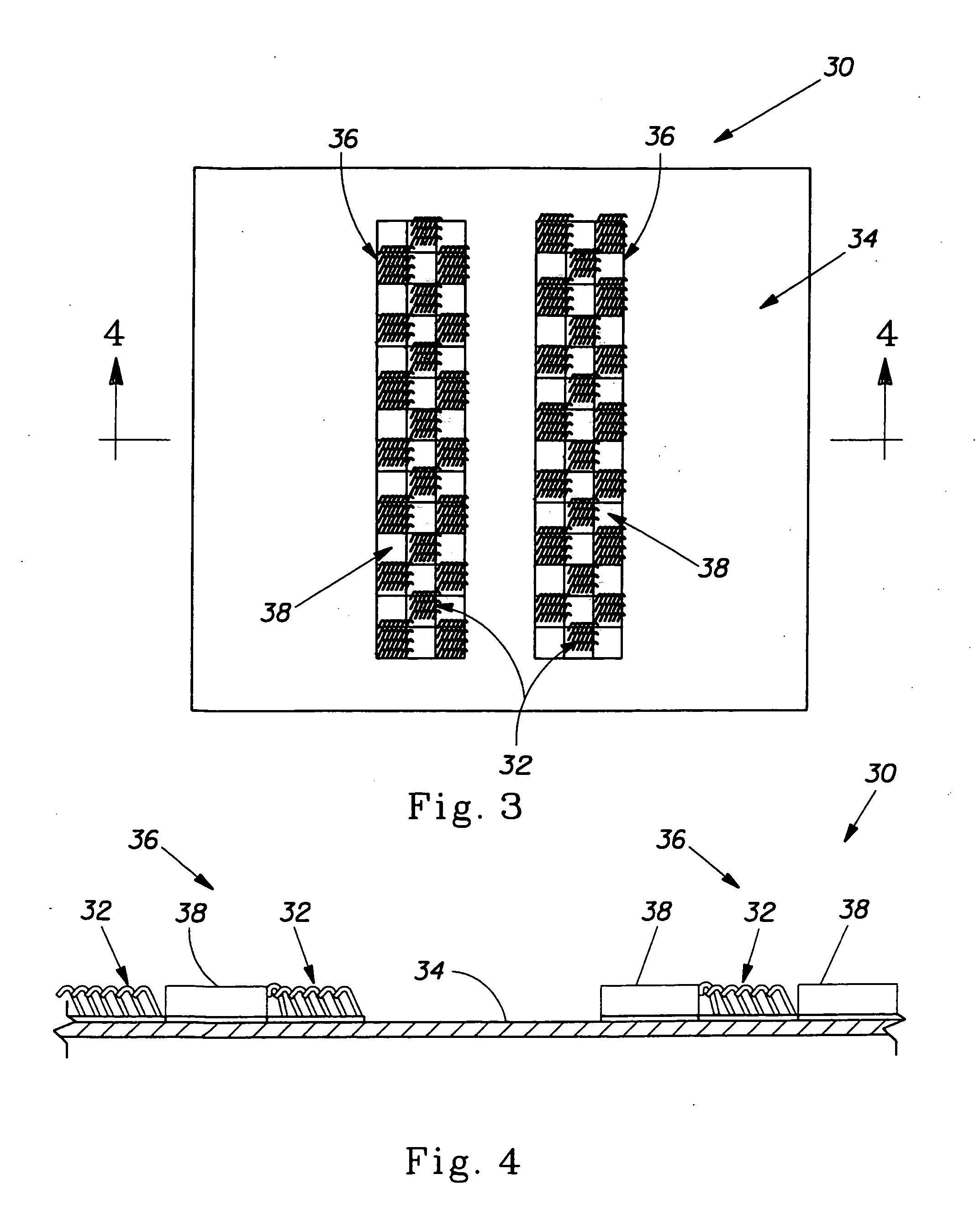Disposable cleaning sheets comprising a plurality of protrusions for removing debris from surfaces
a technology of cleaning sheets and protrusions, applied in the field of cleaning sheets, can solve the problems of difficult to remove unwanted debris from surfaces, difficult to remove conventional vacuum cleaners often do not do a sufficient job in removing pet hair from carpets, etc., to achieve convenient disposal, effective dislodge debris, and convenient disposal
- Summary
- Abstract
- Description
- Claims
- Application Information
AI Technical Summary
Benefits of technology
Problems solved by technology
Method used
Image
Examples
example i
[0199] An example of a cleaning sheet of the present invention, as shown in FIGS. 1 and 2, is produced as follows. First, two nonwoven, hydroentangled substrates having a basis weight of 65 g / m2 and having dimensions of 20 cm×28 cm are adhered together using a two-sided medical adhesive tape (3M Transfer Adhesive #1524) as follows. The first nonwoven, hydroentangled substrate is laid on a flat surface and then the first side of the two-sided tape is adhered to the entire surface of the first nonwoven substrate. The second nonwoven substrate is then adhered to the second side of the two-sided tape to form a laminate substrate. The laminate substrate is then rolled with a 1 to 2 inch diameter roller to ensure good contact and bonding between each nonwoven substrate and the two-sided tape, trimming the edges if necessary.
[0200] Next, two strips of hook material (VELCRO® #088), which have an adhesive backing, are provided having a dimension of 1.25 to 3.8 cm in width and 17 to 20 cm in...
example ii
[0202] An alternative embodiment of the cleaning sheet of the present invention is similar to the cleaning sheet of Example I, except the second nonwoven substrate has two cut-out areas, almost equal in dimension to the two strips of hook material, such that the hook material shows through two cut-out areas of the additional nonwoven substrate, when it is adhered to the first nonwoven substrate to form a laminate substrate. This cleaning sheet is produced as follows. The first nonwoven substrate is laid on a flat surface and the two strips of hook material are positioned on the first nonwoven substrate as shown in FIGS. 1 and 2, and as described in Example I.
[0203] In a preferred embodiment, an additional nonwoven substrate is adhered to the second nonwoven substrate of the laminate substrate by first adhering the first side of a piece of two-sided tape to the second substrate of the laminate substrate and then adhering the additional nonwoven substrate to the second side of the tw...
example iii
[0204] An alternative embodiment of the cleaning sheet of the present invention, as shown in FIGS. 3 and 4, begins with a cleaning sheet as described in Example II, wherein the hook material is between the two layers of substrate and shows through the cut-out areas.
[0205] Using a short, unidirectional, J-type hook material, the cleaning sheet is assembled so that for each strip of hook material the engagement ends of the hooks are facing the same direction. Clear household silicone adhesive caulk is applied directly to the hook material in 1.3 cm squares, such that they alternate in rows between 1.3 cm squares of exposed hook material, similar to the squares of a checkerboard. See FIGS. 3 and 4. After every 5 squares are applied, the silicone is blotted (with a paper towel) so that it completely fills the space between the apex and the base of the hooks, and slightly covers the apex of the hooks. Only small amounts of silicone are used so that the squares don't spread out when blot...
PUM
| Property | Measurement | Unit |
|---|---|---|
| height | aaaaa | aaaaa |
| height | aaaaa | aaaaa |
| softening point | aaaaa | aaaaa |
Abstract
Description
Claims
Application Information
 Login to View More
Login to View More - R&D
- Intellectual Property
- Life Sciences
- Materials
- Tech Scout
- Unparalleled Data Quality
- Higher Quality Content
- 60% Fewer Hallucinations
Browse by: Latest US Patents, China's latest patents, Technical Efficacy Thesaurus, Application Domain, Technology Topic, Popular Technical Reports.
© 2025 PatSnap. All rights reserved.Legal|Privacy policy|Modern Slavery Act Transparency Statement|Sitemap|About US| Contact US: help@patsnap.com



